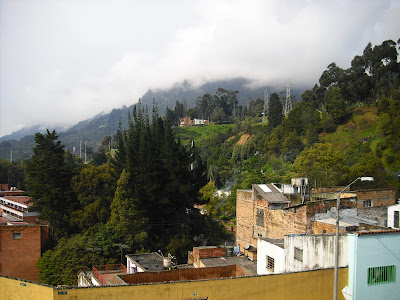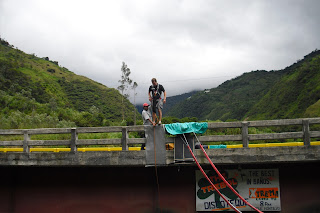There seems to be a bit of an electricity storm brewing in our quaint home village – one that has been replicated in many places not just in Ireland, but even here in Colombia and across the globe.
It’s over proposals to erect electricity pylons in the area – all part of what’s being described as essential upgrading of the country’s power network by the state-owned company EirGrid.*
Those opposed to them, from what we can gather from afar, have as one of their main arguments that these pylons cause cancer. Of course, as we all know and very often with reason, any mention of the big ‘C’ sends people into hysterics.
However, studies examining the link of such pylons to an increased cancer risk are inconclusive, to say the least. One published in the British Medical Journal in 2005 for example, titled ‘Childhood cancer in relation to distance from high voltage power lines in England and Wales’, had the following conclusion:
“There is an association between childhood leukaemia and proximity of home address at birth to high voltage power lines, and the apparent risk extends to a greater distance than would have been expected from previous studies. About 4% of children in England and Wales live within 600 m of high voltage lines at birth. If the association is causal, about 1% of childhood leukaemia in England and Wales would be attributable to these lines, though this estimate has considerable statistical uncertainty. There is no accepted biological mechanism to explain the epidemiological results; indeed, the relation may be due to chance or confounding.”**
Far from irrefutable and plenty of doubt still exists. Indeed, it would seem quite irrational to have the cancer link as your main argument against these pylons. Naturally occurring chemicals in the fruit and vegetables we eat could carry a more carcinogenic threat – just not enough studies have been carried out in this area.
 |
| Storm clouds gathering in Creevy. |
It’s over proposals to erect electricity pylons in the area – all part of what’s being described as essential upgrading of the country’s power network by the state-owned company EirGrid.*
Those opposed to them, from what we can gather from afar, have as one of their main arguments that these pylons cause cancer. Of course, as we all know and very often with reason, any mention of the big ‘C’ sends people into hysterics.
However, studies examining the link of such pylons to an increased cancer risk are inconclusive, to say the least. One published in the British Medical Journal in 2005 for example, titled ‘Childhood cancer in relation to distance from high voltage power lines in England and Wales’, had the following conclusion:
“There is an association between childhood leukaemia and proximity of home address at birth to high voltage power lines, and the apparent risk extends to a greater distance than would have been expected from previous studies. About 4% of children in England and Wales live within 600 m of high voltage lines at birth. If the association is causal, about 1% of childhood leukaemia in England and Wales would be attributable to these lines, though this estimate has considerable statistical uncertainty. There is no accepted biological mechanism to explain the epidemiological results; indeed, the relation may be due to chance or confounding.”**
Far from irrefutable and plenty of doubt still exists. Indeed, it would seem quite irrational to have the cancer link as your main argument against these pylons. Naturally occurring chemicals in the fruit and vegetables we eat could carry a more carcinogenic threat – just not enough studies have been carried out in this area.
 |
| Pylons - eyesores or part of the landscape? |
There are plenty of substances in the world that can give you cancer that we surround ourselves with every day. Yet we tend not to overly worry about the majority of these – it would be illogical to do so and you wouldn’t have much of a life if you did.
Statistics from Britain show that the death rate from childhood cancer is 3.2 per 100,000 children (from about 13 per 100,000 children that actually get the disease) - that's all forms of cancer remember, wherever it was contracted from.
Now put that alongside the estimated 1 in 10,000 chance of being struck by lightning in your lifetime, something which could kill you or leave you severely disabled. Also, US stats state you have a 1 in 98 chance of being killed in a car crash throughout your life, but we're not abandoning our vehicles in huge numbers just yet.
Unduly worrying about some life-threatening risks while ignoring others can lead to not just poor decision-making but even unnecessary deaths.
Take, for example, the 12-month period after the 9/11 terrorist attacks in the USA. Due to the horrific images of the planes crashing into the Twin Towers that we all witnessed, this persuaded many to stop flying as a means of transport.
The fact that you are statistically safer in a plane – terrorist attacks considered – than in a car didn’t matter. With the extra traffic on US roads as a result of this, it has been calculated that an additional 1,595 lives were lost on America’s highways and byways in the year immediately after the 11th of September, 2001. Lives that could have been saved had people made a rational risk analysis.***
So coming back to the pylon issue, the biggest argument we have against them – much more pressing than the dubious cancer link as far as we’re concerned – is the visual pollution that they’ll bring to the area. At a likely height of about 50 metres (from what we can gather the exact pylon type has yet to be decided), they’re not exactly going to blend in seamlessly with a landscape that has just a mildly undulating topography.
Could the cables they'll carry be put underground? It would appear that international practice is to have them over-ground – perhaps burying them in the earth could be worse for the environment and no doubt would make maintenance work more cumbersome.
As for many of these often essential man-made structures for the continued development of a country, there exists the case of ‘not in our backyard’.
The experts – and we must trust that this is what they are – who work in maintaining and upgrading Ireland’s electricity supply believe the construction of such pylons to carry the high-voltage cables is needed. In that case, they have to go somewhere. This time our little village is in the firing line and it seems pretty inevitable that they’re going to be built – ‘in the national interest’.
As a good friend said, perhaps we could make a tourist attraction out of them. Anyone up for a spot of bungee jumping in Lisacul?
_______________
*For more information on the project, see: http://www.eirgridprojects.com/projects/gridwest/
**Full report can be found on the British Medical Journal website at: http://www.bmj.com/content/330/7503/1290
***For further information on the majority of the statistics quoted, as well as being essential reading on risk, see ‘Risk: The Science and Politics of Fear’, Dan Gardner, Virgin Books, 2009.
So coming back to the pylon issue, the biggest argument we have against them – much more pressing than the dubious cancer link as far as we’re concerned – is the visual pollution that they’ll bring to the area. At a likely height of about 50 metres (from what we can gather the exact pylon type has yet to be decided), they’re not exactly going to blend in seamlessly with a landscape that has just a mildly undulating topography.
Could the cables they'll carry be put underground? It would appear that international practice is to have them over-ground – perhaps burying them in the earth could be worse for the environment and no doubt would make maintenance work more cumbersome.
 |
| Extreme sports for Lisacul? |
As for many of these often essential man-made structures for the continued development of a country, there exists the case of ‘not in our backyard’.
The experts – and we must trust that this is what they are – who work in maintaining and upgrading Ireland’s electricity supply believe the construction of such pylons to carry the high-voltage cables is needed. In that case, they have to go somewhere. This time our little village is in the firing line and it seems pretty inevitable that they’re going to be built – ‘in the national interest’.
As a good friend said, perhaps we could make a tourist attraction out of them. Anyone up for a spot of bungee jumping in Lisacul?
_______________
*For more information on the project, see: http://www.eirgridprojects.com/projects/gridwest/
**Full report can be found on the British Medical Journal website at: http://www.bmj.com/content/330/7503/1290
***For further information on the majority of the statistics quoted, as well as being essential reading on risk, see ‘Risk: The Science and Politics of Fear’, Dan Gardner, Virgin Books, 2009.
I think they should investigate running a cable car service on the pylon system.
ReplyDeleteIngenious Micheál - if they run them by Creatons then you've a drink-driving solution, public transport service & tourist attraction all in one...
ReplyDeleteWe want in on this!
would be very senic a trip from Creevy to Bangor!
ReplyDeleteCould get one of those hop on, hop off tourist tickets just like on the Dublin buss tours!
This has potential - we must get on to EirGrid post-haste...
ReplyDeletedunno about your conclusion on the road accidents in america after september 11th. in 2002 there were 43,005 fatalities on the american "highways and byways", i think you'll find the "extra" 1,595 seems to be well within the standard deviation. it hit a peak in 2005 with 43,510, what can we accredit that to? classic case of correlation without causation. takes the credibility out of the piece for me, sorry.
ReplyDeleteNo need to be sorry for your opinion Anonymous.
ReplyDeleteThe numbers in the piece though come from an extensive study carried out by Gerd Gigerenzer at the Max Planck Institute in Berlin.
He compared travel and fatality statistics in the US for the period five years prior and five years after 9/11.
His data found that more people travelled by road in the year immediately after 9/11 and road fatalities also peaked during that period, falling back to 'normal' levels thereafter.
You'll find this information and further data in the 'Risk' book referenced above.
Thanks